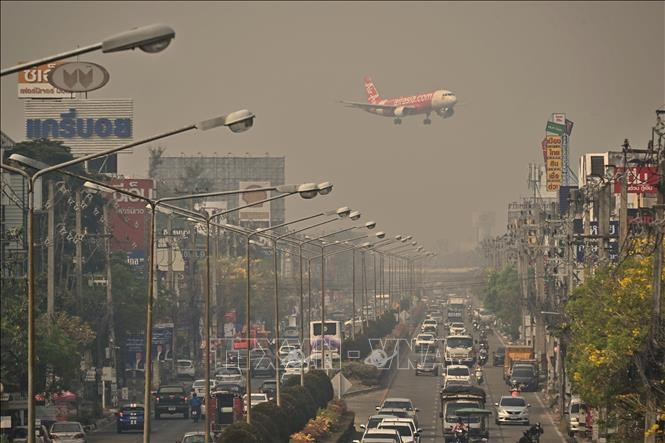Countries across Asia are recording record high temperatures as a severe April heatwave continues to grip large areas with no signs of abating.
According to CNN on April 19, in Southeast Asia, some countries announced the highest temperatures ever recorded this week.
According to weather historian Maximiliano Herrera, Laos is the latest country to set a new all-time temperature record when the city of Luang Prabang recorded a temperature of 42.7°C on April 18.
Data from the Thai Meteorological Department showed temperatures reached 45°C over the weekend, the first time in Thailand’s history that temperature has been recorded. The northwestern city of Tak recorded 45.4°C on April 15, but much of Thailand has been in the 40s since late March.
Earlier this month, Thai authorities issued a health warning for several provinces as the heat index forecasted a high of 50.2°C in the Bang Na district of the capital Bangkok. The heat index is a measure of perceived heat and takes into account both temperature and humidity to measure the impact of heat. On April 18, Thai Prime Minister Prayut Chan-o-cha expressed concern about dangerously high temperatures in parts of Thailand, saying temperatures could reach 52.3°C in the Bang Na district of Bangkok.
Meanwhile, Myanmar set an April temperature record on April 17 when Kalewa in the central Sagaing region reached 44°C.
April and May are typically the hottest months of the year in South and Southeast Asia as temperatures rise before the monsoon rains begin and cool the temperatures.
But the heat in Thailand also coincides with the thick smog season, which has caused pollution levels to spike. The tourist hotspot of Chiang Mai in northern Thailand has been ranked the world’s most polluted city for seven consecutive days as smoke from widespread forest fires and slash-and-burn agriculture has degraded air quality. At least one hospital in the city said it was running out of space as patients sought treatment for respiratory problems.

Severe smog pollution in the tourist city of Chiang Mai. Photo: AFP/TTXVN
Scorching temperatures have also spread across China. On April 18, temperatures reached 42.4°C in Yuanyang, southeast China, just 0.3°C off the national April record.
According to climatologist Jim Yang, on April 18, more than 100 weather stations in 12 provinces in China broke April temperature records.
While not record-breaking in most cases, heat waves have been widespread and deadly across South Asia. Pakistan, India, Nepal and Bangladesh have all seen temperatures top 40°C for days.
According to the India Meteorological Department, 48 weather stations recorded temperatures above 42°C on April 18, with the highest being 44.2°C in the eastern state of Odisha.
In the western state of Maharashtra, at least 13 people died of heatstroke after attending a state awards ceremony on April 16. Over 1 million people attended the event in Navi Mumbai and about 50 to 60 people were hospitalized, according to a city police official.
Meanwhile, at least two states, Tripura in the northeast and West Bengal in the east, have ordered schools to close this week as temperatures rose more than 5°C above normal.
The Ministry of Labour has issued advisories to all states and districts to ensure the safety of workers, especially outdoor workers and miners. The recommendations include providing adequate drinking water, emergency ice packs and taking frequent breaks.
Heat waves in India typically occur between March and July. However, in recent years, they have become more intense, more frequent and longer lasting. Last year, India experienced a severe heat wave, with temperatures reaching over 49°C in many areas.

A rickshaw puller splashes water on his face to relieve the heat in Dhaka, Bangladesh on April 16. Photo: Getty Images
As the impacts of the climate crisis intensify and global temperatures continue to rise, scientists say heat waves will only become more common. A 2022 study found that dangerous heat waves will occur three to 10 times more frequently by the turn of the century.
Research shows that in tropical regions, including much of Asia, people can be exposed to dangerous heat most days of the year. Days with “extremely dangerous temperatures” of 51°C (122°F) could double, and experts say those temperatures are already putting people at risk.
Extreme heat across South and Southeast Asia is expected to continue. Meanwhile, cooler weather is on the horizon across much of China as temperatures are forecast to drop later this week.
According to Tin Tuc Newspaper